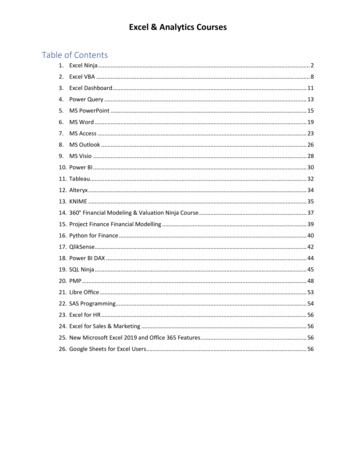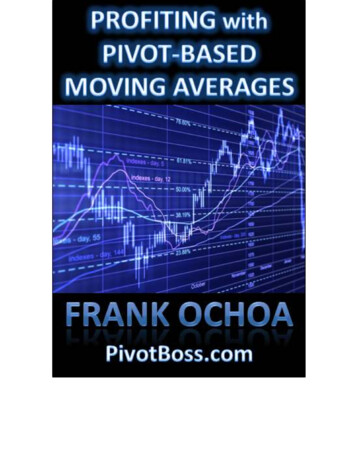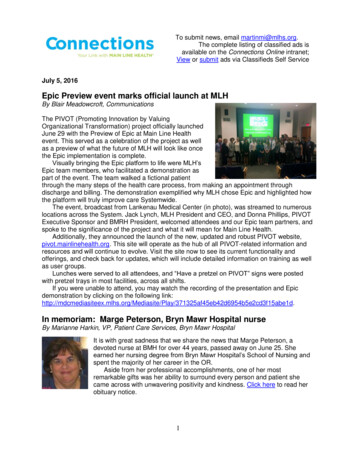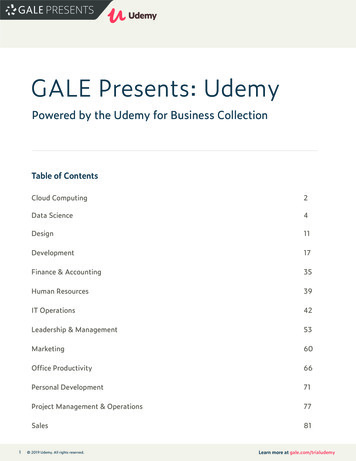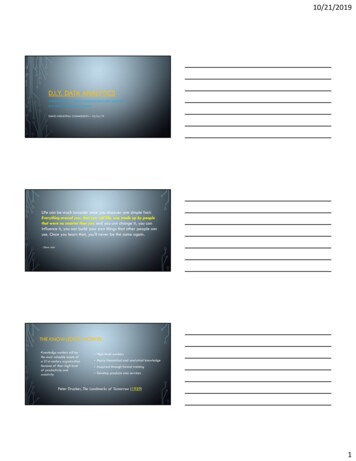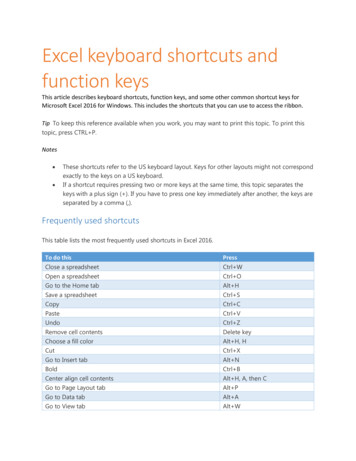
Transcription
“Pivot is a book you will turn to again and again, whether you’re seeking a newcareer direction, a second career after retirement, or just on the lookout for newways to use your talents. Jenny Blake takes a strength-based approach tomanaging the risk that comes with making a change, and provides tons ofhelpful examples and exercises.”—Daniel H. Pink, author of To Sell is Human and Drive“Nontraditional career journeys are not only the new normal, they’re howinnovators throughout history changed their world and ours. With actionableinsights and lucid prose, Jenny Blake illuminates the path to building your owndestiny.”—Shane Snow, author of Smartcuts and cofounder of Contently“Wondering what your next move is? Read this book! Jenny Blake is one of thewisest and freshest voices on the subject of career development, and this is herbest work yet. In Pivot, you will hear the good news: that you can get paid to dowhat you love. It may not look like what you thought, and it may require somepersonal growth, but you can find the work you were meant to do. You justhave to pivot.”—Jeff Goins, author of The Art of Work“Are the tectonic plates below your sturdy career suddenly splitting into a deepabyss of unknown? Let this book be your rope ladder out.”—Neil Pasricha, author of The Happiness Equation and the 1,000 Awesome Things blog“If you think life is a highway, then you’ve got it wrong. It’s more like awinding path through an unpredictable forest. Not only do you have to wade theswamp and battle the beasts, but time after time you come to a crossroads. Left?Right? Straight ahead? Jenny Blake’s new book will help you find the wisdomand resources to make the best choices, move into the sunlight, and end upwhere you want to be.”—Michael Bungay Stanier, author of The Coaching Habit and Do More Great Work
“We live in a time of rapid evolution, and we develop skills quickly now byabsorbing many shorter term work experiences, so we can become what JennyBlake calls impacters in our careers. This book gives you a solid roadmap tomaking the right call about career changes that will help you discover whatyou’re truly built for. Courage, consciousness, and competence—that’s whatPivot offers you. It’s excellent!”—Penney Peirce, author of The Intuitive Way, Frequency, and Leap of Perception“The book is fantastic. No matter where you are in your career, Pivot isprovokingly relevant.”—Dr. Tom Guarriello, founder of RoboPsych and founding faculty at New York’s School ofVisual Arts, Masters in Branding“Today, the average person has eleven jobs and three to six careers, which iswhy Pivot is essential reading for every professional. Let Jenny be your coach,giving you the confidence and tools required to make your next careertransition. Whether you’re an employee, freelancer, or entrepreneur, this bookwill help you identify the skills you have or need that will lead to your nextopportunity. Jenny has been through career transitions and has successfullynavigated them on her own, which makes her the perfect spokesperson forhelping you do the same. Pivot is the book that you’ll need to read multipletimes through your life because change is constant and often times unexpected!”—Dan Schawbel, author of Promote Yourself and Me 2.0“Whether you’re considering a career change or job change, or figuring out whatto do next, Jenny Blake’s Pivot is the book you need. It’s a comprehensive,practical, must-have guide to your pivot.”—Susan RoAne, keynote speaker and author of How to Work a Room
Portfolio / PenguinAn imprint of Penguin Random House LLC375 Hudson StreetNew York, New York 10014Copyright 2016 by Jenny BlakeIllustrations by ABC Design Lab, copyright 2016 by Jenny Blake.Penguin supports copyright. Copyright fuels creativity, encourages diverse voices, promotes free speech,and creates a vibrant culture. Thank you for buying an authorized edition of this book and for complyingwith copyright laws by not reproducing, scanning, or distributing any part of it in any form withoutpermission. You are supporting writers and allowing Penguin to continue to publish books for every reader.LIBRARY OF CONGRESS CATALOGING-IN-PUBLICATION DATANames: Blake, Jenny, author.Title: Pivot : the only move that matters is your next one / Jenny Blake.Description: New York : Portfolio, 2016.Identifiers: LCCN 2016011437 ISBN 9781591848202 (hardback) ISBN 9780698406704 (ebook) ISBN9780399564383 (international edition) Subjects: LCSH: Career development. Career changes. BISAC:BUSINESS & ECONOMICS Careers General. BUSINESS & ECONOMICS / Motivational.Classification: LCC HF5381 .B455 2016 DDC 650.14—dc23 LC record available athttps://lccn.loc.gov/2016011437Version 1
To my grandma Janice Deino, who pivoted her entire life at eighty yearsold with strength and grace. You are an unwavering source of support andinspiration, and the most agile, resilient person I know. Thank you foreverything.
How should we be able to forget those ancient myths that are at thebeginning of all peoples, the myths about dragons that at the lastmoment turn into princesses; perhaps all the dragons of our livesare princesses who are only waiting to see us once beautiful andbrave. . . .So you must not be frightened . . . if a sadness rises up beforeyou larger than any you have ever seen; if a restiveness, like lightand cloud-shadows, passes over your hands and over all you do.You must think that something is happening with you, that life hasnot forgotten you, that it holds you in its hand; it will not let youfall.—Rainer Maria Rilke, Letters to a Young Poet
CONTENTSPraise for PivotTitle PageCopyrightDedicationEpigraphINTRODUCTION: PIVOT IS THE NEW NORMALPivot or Get PivotedChanging Careers in the Age of the AppConnect the Dots Looking BackwardPivot Method at a GlanceHIGH NET GROWTHCareer Operating ModesTrust Your Risk ToleranceTwo (Many) Steps Ahead, One Step BackSTAGE ONE: PLANTPLANT OVERVIEWCHAPTER 1: CALIBRATE YOUR COMPASS
What Are Your Guiding Principles? What Is Your Happiness Formula?Create Your CompassIdentify Your Happiness FormulaYour Body Is Your BusinessReduce Decision FatigueMeditate to Activate Your Best InstinctsCHAPTER 2: PUT A PIN IN ITWhat Excites You Most? What Does Success Look Like One Year from Now?Avoid the Tyranny of the HowsVision Cloudy? Start Somewhere.Clarify Your Vision StatementSummarize Knowns and UnknownsCHAPTER 3: FUEL YOUR ENGINEWhat Is Working? Where Do You Excel?Identify Your StrengthsWork-History HighlightsCHAPTER 4: FUND YOUR RUNWAYWhat Is Your Timeline? How Can You Earn Extra Income?Build a Solid Financial FoundationPivot Finance 101Income-Anxiety Seesaw AwarenessSTAGE TWO: SCANSCAN OVERVIEWCHAPTER 5: BOLSTER YOUR BENCHWho Do You Already Know? Who Can Provide Advice? What Can You Give in Return?Expand Your Sphere of InfluenceBuild a Network of Collective BrainpowerCareer Karma: Seek Reciprocal Success
CHAPTER 6: BRIDGE THE GAPSWhat Skills and Expertise Will Take You to the Next Level?Mind the GapLearn How to LearnLimit Linear ThinkingInvestigative ListeningBe Discerning About Your LearningCHAPTER 7: MAKE YOURSELF DISCOVERABLEHow Can You Add Unique Value and Build Visibility?Define Your Project-Based PurposePlatform and LeverageRevel in the Work Others RejectLeapfrog: Work Backward from Two Moves AheadLet Others Know You Are LookingSTAGE THREE: PILOTPILOT OVERVIEWCHAPTER 8: GET SCRAPPYWhat Small Experiments Can You Run? What Real-World Data Can You Collect?Aim First for Quantity, Not QualityWhat Makes a Strong Pilot?Incremental Pilots Within OrganizationsReduce Risk with RedundancyTravel Pilots to Shake Up Stagnant ThinkingCHAPTER 9: PAUSE, REVIEW, REPEATWhat Worked? What Didn’t? What Could You Do Differently?Pause and ReviewTake Incrementally Bigger Risks
STAGE FOUR: LAUNCHLAUNCH OVERVIEWCHAPTER 10: BUILD FIRST, COURAGE SECONDWhen Will You Make the Big Move? What Are Your Linchpin Decision Criteria?Identify your Launch Timing CriteriaPivot HexagonKnow When to Hold Versus FoldYour Gut Has a BrainPivot Scales: Comfort Versus RiskCHAPTER 11: FLIP FAILUREWhat Will Move You into Action?Rejection as a Stepping-Stone to SuccessMine Failure for StrengthsYou Can’t Make Everybody Happy—So Stop Trying and Start LivingSeparate Decisions from Difficult ConversationsDon’t Wait for Perfect ConditionsHow Do You Know Your Launch Worked?The Continuous PivotSTAGE FIVE: LEADLEAD OVERVIEWCHAPTER 12: ARE YOU LISTENING?How Can You Facilitate Engaging Career Conversations?Your Interest Matters More Than You ThinkHow to Use the Pivot Method Within OrganizationsPilot Creative Internal-Mobility ProgramsCONCLUSION: CELEBRATE COMPLEXITY
Checking In at the Last ResortThe Courageous LifeACKNOWLEDGMENTSPOST PIVOT: ONLINE RESOURCESPIVOT METHOD QUICK REFERENCELAUNCH CRITERIA CHECKLISTRESOURCES FOR COMPANIESPIVOT 201: RECOMMENDED READINGNOTESINDEX
INTRODUCTION: PIVOT IS THENEW NORMALChaos is merely order waiting to be deciphered.—José Saramago“I think I am going crazy.”“I don’t know what’s wrong with me.”“Am I asking for too much?”“I just can’t do this anymore.”“I think I am having a midlife crisis.”“Will I ever be happy?”NO MATTER THEIR AGE, LIFE STAGE, BANK ACCOUNTBALANCE, OR CAREER LEVEL, these are the sentiments I hear frompeople who are looking for more in their lives, even if they have found careersuccess by traditional standards.Many have perfect-on-paper jobs, but have hit a plateau and feel aninexplicable urge to do things differently. They may be considering walkingaway from a robust salary, folding or starting their own business, or taking timeoff altogether. Some are unsatisfied or frustrated with their work for otherreasons: they have outgrown their position or business, or they feel drawn to anew area that better suits their values and interests, where they can make agreater contribution.
Through their confusion and self-doubt, one thing remains clear: the waythey have been working is no longer working. Maybe you can relate to some ofthe following stories of people who reached a career crossroad:Amy Schoenberger had been working as a senior creative strategistin a public relations firm for four years. She was starting to feeluninspired by the work, but had no desire to leave the company andcoworkers she loved.After several tumultuous years in his late twenties, AdamChaloeicheep hit a point of physical and emotional burnout. Hewondered, Is this all there is? Adam needed time to reflect and reset,so he left his lucrative job as creative director of a real estatedevelopment firm, sold nearly all his possessions, and moved fromChicago to Thailand to study meditation in a monastery.Tara Adams had been at Google for eleven years running educationaloutreach programs when she felt the urge to slow the frenetic pace ofher career and start a family, perhaps even take a break from work.After graduating from UCLA, Marques Anderson spent four years inthe NFL as a safety. He started playing for the Green Bay Packers,then after three years got traded to the Oakland Raiders before a finaltrade to the Denver Broncos one year later. Though he loved his timein the league, Marques also knew that it was important to have atransition plan for what would follow.Kyle Durand was on active duty in Iraq, practicing international andoperational law, when he found out he had been passed over forpromotion after seventeen years of service. After receiving the newsin a brief phone call with his commanding officer, he left his office(located at the time in Saddam Hussein’s palace) and walked back tohis tent in the middle of the night. While he pondered his fate, arocket suddenly shot over his head, hit a fuel bladder on a nearbyrunway, and exploded. At that moment, Kyle knew it was time toreturn home. He was devastated by the phone call, and no longerwanted to risk his life for an organization that did not seem to valuehis efforts.As John Hill and Bud Bilanich approached big birthdays—sixty andsixty-five years old, respectively—friends, family, and colleagues
repeatedly asked if they would retire. As they considered how thenext phase of their careers might unfold, one constant remainedstrong: neither had any interest in clichéd notions of retirement thatinvolved stopping work completely.Brian Jones (not his real name) and Julie Clow were executives whohad outgrown their senior-level leadership roles at prestigiouscompanies and felt capped in their trajectories. However, withfamilies to support and large financial packages at their current jobs,leaving would not be an easy choice.I had been working at Google in training, coaching, and careerdevelopment for over five years when I took a sabbatical to launchmy first book, Life After College, in 2011. Even though I lovedworking there and had a perfect-on-paper role myself, something wasstill missing.From the outside, it may have looked like we were all undergoing quarterlife or midlife crises. Onlookers might have wrongly assumed we were fallingapart or going crazy for seeming unsatisfied with our current paths and leavingour stable jobs behind.However, on the inside we all knew we had hit a plateau, or pivot point, inour careers. We were talented, hardworking, and committed to making a positiveimpact—and yet we all felt called to do things differently than how we had beendoing them. Tackling these massive changes felt disorienting but right. Forwhatever uncertainties lay ahead, each of us knew that staying in the same placewould have been the greater risk.Calling such career aspirations a crisis, shaming and blaming people forwanting to prioritize meaningful work in a volatile economy by saying they are“entitled” or “too picky,” means we are missing a huge opportunity to celebrateand support those who seek to make a greater contribution to their workplaces,society, and the lives of everyone around them.We do not have a productive description for this type of career transition. Orat least we didn’t, until now.PIVOT OR GET PIVOTED
People are no longer working at the same jobs for forty years with the safety ofpension plans waiting at the end. The average employee tenure in America isnow four to five years and job roles often change dramatically within those fourto five years. Among workers twenty-five to thirty-four years old, the averagetenure drops to three years.Many jobs that disappeared during the last recession are not coming back.Every day, breakthroughs in technology generate greater automation in theworkplace, threatening positions held by hardworking people and the stability ofcompanies large and small. Job security has become an antiquated idea, a luxurymost people today do not enjoy, whether they are aware of it or not.Corporate loyalty has given way to uncertainty; companies that seem too bigto fail have collapsed, along with many smaller ones. New ones take their place.With the advent of app marketplaces, crowdfunding, the maker revolution, andsharing economies, we now see billion-dollar valuations for companies thatwould not have existed ten years ago, and many smaller businesses cropping upin parallel.To add to the upheaval, a recent Gallup study revealed that almost 90percent of workers are either “not engaged” or “actively disengaged from theirjobs.”But you do not need to read any of the statistics, books, or articles to have avisceral sense of this volatility. “Virtually everything about jobs and work andcareers has changed,” said Scott Uhrig, an executive recruiter for technologyfirms and author of Navigating Successful Job Transitions. “Just like the boilingfrog, we may not fully appreciate the magnitude of the change even though weare completely immersed in it.” Perhaps you are currently experiencing thisboiling frog feeling in your career—if you have not already jumped out of thepot.Some say the word career itself is dead—a throwback to a bygone era—aswe move increasingly toward a project-based economy. Certainly, we can expectto experience significant changes every few years, much more often than wassocially acceptable in the past. Because our careers are so fundamentally tied toour livelihood and sense of confidence, meaning, and purpose, these transitionscan be traumatic without a road map for traversing them.But this doesn’t all have to be bad news. Navigating this accelerated pace ofchange and this transitional career state, learning to embrace it instead ofresisting it, can become an edge and advantage. You can learn to enjoy
calculated risk and uncertainty in exchange for adventure, flexibility, freedom,and opportunity.By approaching their career transitions in a positive, methodical way, eachof the people whose stories I shared earlier recalibrated toward more resonanttrajectories:Amy sought to prove her value at her PR firm by taking on theprojects that no one else wanted to do. In 2009, when it becameincreasingly clear that social media and blogger outreach wereimportant for PR strategy, she volunteered to learn more about it—ajob others in the company avoided, for fear of lowering their statusby working with bloggers instead of marquee clients. Amy soondeveloped a reputation as the company’s social media expert,consulting on all the biggest accounts and parlaying this expertiseinto a new role as director of digital entertainment.When he returned to the States after eight months abroad, Adamknew he wanted to combine his interests in fashion, technology,brand strategy, and entrepreneurship. He applied and was acceptedinto Parsons Business of Design graduate program, which helpedbuild his skills, business acumen, and network over the followingtwo years. After graduation, Adam remained in New York City,where he and his company, ABC Design Lab, are thriving.Tara had never lived outside of California, but had a hunch thatmoving to and working remotely from New Orleans, where she hadbeen volunteering annually since Hurricane Katrina, would be theexact refresh her life needed. Within one year, Tara met a man, gotengaged, and made the tough decision to quit her job. After takingoff a year to have a baby, she returned to work as a consultant in thenonprofit sector for large-scale social impact programs.Inspired by a fortuitous meeting with a soon-to-be mentor on the dayhe was traded from the Raiders to the Broncos, Marques decided topursue his master’s degree in Adult Learning and Global Change at auniversity in Sweden after retiring from the NFL. A few years laterhe founded the World Education Foundation, and now travels theworld launching initiatives in developing nations to create “improvedhuman experiences in health, education, infrastructure, and sports.”
When Kyle first returned home to the States after serving in theMiddle East in 2006, he said, “I was completely lost. That transitionwas like someone dropping me off in the middle of the desert. Ididn’t know what the hell to do with myself.” He downshifted hismilitary involvement, switching to part time in the reserves, andresolved to work for himself so that he could take control of his lifeand “never let someone else determine his future.” Kyle went on tobuild a suite of companies, including an IT hardware company, a taxlaw and accounting practice, and a scalable contracts service forentrepreneurs called OurDeal.When the company he was working for got acquired, having servedas a chief information officer for twenty-two years, John said he waslooking forward to a next phase in his career, but had no plans toretire. Within five months of exploring, and allowing himself thefreedom to focus more time on his love of travel and photography, heaccepted a role as chief operations officer at a global cloudcomputing software company, his largest role to date. Bud was in asimilar position, having spent twenty-five years on the road andready for a transition that wasn’t retirement. He shifted his consultingbusiness online to spend more time at home. “This is legacy time,”Bud said, noting that he, too, plans to continue working for at leastanother ten years.After Brian and Julie exhausted their options internally and openedthemselves up to pushing past their career plateaus by switchingcompanies, job offers for full-time leadership roles seemed to fallfrom the sky. Both were “poached”—sought out by recruiters basedon their reputation and work history—for dream roles: Brian assenior vice president of engineering for a start-up company, and Julieas head of global people development for Chanel.In 2011, I made the difficult decision to leave Google after mysabbatical and launch a full-time business based on my blog andrecently released book. People reacted as if I were breaking up withBrad Pitt. “You really think you can do better than Gooooogle?!” Iwasn’t sure, but I knew I would forever regret not trying. So I rentedout my condo, packed a suitcase, and moved from Silicon Valley toNew York City. I have been running my own company in the years
since as a career and business strategist, writer, and keynote speaker.I am the happiest and healthiest I have ever been. Even as mybusiness goes through ups and downs, I feel calm and engaged withmy work.As much as we began from similar places of dissatisfaction, our stories allhave something in common with how we proceeded, too. We each shifted tonew, related work by leveraging our existing base of strengths, interests, andexperience. Though it might seem as if each of us made drastic changes, wewere not starting from scratch. In Silicon Valley parlance, we pivoted.Eric Ries, author of the business bible The Lean Startup, defines a businesspivot as “a change in strategy without a change in vision.”I define a career pivot as doubling down on what is working to make apurposeful shift in a new, related direction. Pivoting, as we will refer to it in thisbook, is an intentional, methodical process for nimbly navigating career changes.Typically when the word pivot is applied to a business strategy shift, it isconsidered Plan B: changing directions to save a business from dwindling profitsor a dismal forecast. Pivoting was a response to failing at Plan A, the originalgoal. But when it comes to our careers, learning to pivot is Plan A. Pivoting,within our roles and throughout our careers, is the new normal.Punctuated moments of career success—promotions, launches, and financialwindfalls—are nice, but they are only a tiny fraction of our overall experience.By doubling down on what is working best while thinking about how to developinto what’s next, you accelerate the experimentation and change process. Youcan proceed with confidence, knowing that you already have what it takes to getwhere you want to go.Your choice, today and in the future, is to pivot or get pivoted. Pivoting is amindset and a skill set, and you can get better at both. In this book I will share aframework to help you manage the process with focus, fulfillment, and—dare Isay—fun.CHANGING CAREERS IN THE AGE OF THE APPCareers are no longer straightforward, linear, and predictable like ladders. Theyare now much more modular, customizable, and dynamic, like smartphones. Oureducation and our upbringing are the out-of-the-box model. After that, it is up to
us to download the apps—for skills, interests, experiences, and education—thatwe want and need to feel fulfilled.But what do you do when your entire operating system needs an upgrade? Itis not as easy as clicking “update now” and waiting five minutes for shiny newfeatures to set in. We are not machines; we are flawed, fear-prone, desire-driven,sometimes irrational, endlessly creative human beings.Career changes seem to threaten our most fundamental needs on Maslow’shierarchy: food, shelter, clothing, and safety, in addition to higher-level needsfor belonging, esteem, and even self-actualization. We are afraid that if we makeone wrong move, we will soon become homeless (or forced to live in ourparents’ basement) and unemployed, unable to fend for our very survival.Perceiving this potential threat to our primary needs, we freeze, flee, or fight thenagging voice within us that seeks greater fulfillment.As Stephen Grosz writes in The Examined Life, “All change involves loss.”It is natural to fear change when we know that we must grieve what we mayleave in its wake. Even the most exciting changes can be bittersweet, as theyoften involve letting something else go.But many of us fear change for a more irrational reason: we anticipateworst-case scenarios, which may or may not occur. To remain calm and to haveaccess to our most creative faculties, we must learn to see the new career changelandscape as normal, expected, and part of a revolution ripe with opportunity. Asmy friend Monica’s mother advises when she worries about the future, “Don’tsuffer twice.”In the career-as-smartphone analogy, pivoting is about learning to downloadapps one by one—or a few smaller apps simultaneously—so you can reducerisk, experiment with ideas, and enhance your career operating system withoutsending yourself into a panic by trying to make moves that are too drastic, toofar removed from what you are doing right now.You will never see the entire pivot path at the outset, nor would you want to.If the next steps were obvious and manageable with a simple spreadsheet, youwould either already be taking them or you would be bored. The exhilaratingpart of tackling new opportunities is the inherent risk and uncertainty involved.It is the “call to adventure” from Joseph Campbell’s Hero’s Journey archetype,which necessitates that we venture into the land of the unknown and becomebigger, more fully expressed versions of ourselves in the process.
What Is the Difference Between a Crisis and a Pivot?There are certain life events that are all consuming; they rock us to the core, break us down, and torchthe world as we knew it. The death of a loved one, disease, divorce, getting fired—all of these can beextremely traumatic. To call them pivot points would be a gross understatement.A pivot is change you make of your own volition when you have reached a point in your careerwhen you are ready for increased challenge and impact. Traumatic events, ones that leave you with thefeeling that you are crawling out of your own skin, are most often not voluntary.Certain events happen to us and they require space for patience, compassion, grief, and sometimestherapy or spiritual guidance in order to heal. These events demand a period of time to retreat, process,and regroup. Sometimes just waking up and making it through the day is an enormous accomplishment.Crises typically require more processing than planning, though not everyone will have the luxury to dothose two things in sequence. It is likely that those in the throes of trauma need time to heal beforeembarking on the more proactive phases of pivoting.In many cases, painful experiences also serve as powerful wake-up calls, encouraging us to rebuildin an even more authentic direction. I recommend books for each Pivot stage in the Pivot 201 section atthe back of the book, but the two I suggest for processing major life events are When Things Fall Apartby Pema Chödrön, and Second Firsts by Christina Rasmussen.CONNECT THE DOTS LOOKING BACKWARDWhen I was twenty years old, I took a leave of absence from UCLA, where Iwas studying political science and communications, to join a political pollingstart-up in Silicon Valley as its first employee. This was my first pivot, and itkicked off my examination of what it takes to switch quickly and successfullyfrom one trajectory to the next, even when it seems to go against the grain ofwhat others are doing.In hindsight I see my entire career as a series of pivots, within companiesand also on my own, where I have made several smaller pivots in my businesssince:After two years at Polimetrix, where my role included managing ourGoogle AdWords accounts, I landed a job at Google in training anddevelopment, teaching customer service representatives how tosupport the AdWords product.Next I pivoted within Google, moving from the AdWords producttraining team to the career development team, a move made easier
after having attended the Coaches Training Institute on weekends tobecome a certified coach. On the career development team, I helpedcreate and launch a global coach training program for managerscalled Career Guru, which made drop-in coaching available to anyGoogler—a program still cited as one of the benefits that makeGoogle a top company to work for.While I was at Google, I started working on a hobby “side hustle”during nights and weekends—my first blog and book, Life AfterCollege. This became the springboard to my next big move, eventhough I had no clue for the first few years that it would eventuallybecome my full-time occupation.When I left Google, I pivoted to launch my own career-consultingand speaking business. I shifted the context of my work environment,but not the content, given that I applied a similar set of strengths andactivities. Two years after that, I expanded my platform to a websiteunder my own name, JennyBlake.me, where I focus on systems at theintersection of mind, body, and business.As Steve Jobs said in his 2005 Stanford commencement speech, “You can’tconnect the dots looking forward; you can only connect them lookingbackward.” The days of mapping an entire career path are over. You do not haveto specify the details of your life five moves or five years out. Consider what youwere doing five years ago. Did you have any idea where you would be today?The challenge now is to be present. In doing so, we stay awake to the dots thatare right in front of us.I encourage you to reflect on your work history and connect the dots lookingbackward to see how you have already pivoted from one related area to the next.It is likely that, before even reading this book, many of these concepts will bethings you have unknowingly applied in your own career.I disagree with Jobs on one point: I do think it is possible to connect at lea
Oct 01, 2015 · —Daniel H. Pink, author of To Sell is Human and Drive “Nontraditional career journeys are not only the new normal, they’re how innovators throughout history changed their world and ours. With actionable insights and lucid prose, Jenny

